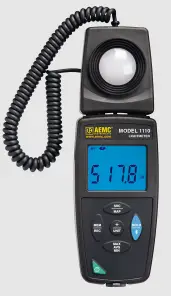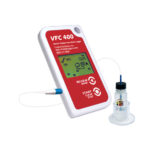AEMC 1110 Light Meter Data Logger
Product Information
- Product Name: Lightmeter Model 1110
- Product Type: Lightmeter Data Logger
- Manufacturer: [Manufacturer Name]
- Serial Number: 2121.71
- Catalog Number: 1110
Product Usage Instructions
Precautions for Use
These safety warnings are provided to ensure the safety of personnel and proper operation of the instrument.
- Read the instruction manual completely and follow all safety information before attempting to use or service this instrument.
- Safety is the responsibility of the operator!
- Tests are to be carried out only on dead circuits! Check for live circuits before making resistance measurements (safety check).
- Always make connections from the instrument to the circuit under test.
- These megohmmeters are sources of high voltage, as is the sample connected to them. All persons performing or assisting in the tests must follow all safety precautions to prevent electrical shock to themselves and to others.
- When testing capacitance samples, make sure that they have been properly discharged and that they are safe to touch. Dielectric insulation samples should be short-circuited for at least five times the amount of time they were energized.
- Never open the back of the instrument while connected to any circuit or input.
Initial Setup
Installing Batteries
- Press the tab of the battery compartment cover and lift it clear.
- Remove the battery compartment cover.
Copyright© Chauvin Arnoux®, Inc. d.b.a. AEMC® Instruments. All rights reserved.
No part of this documentation may be reproduced in any form or by any means (including electronic storage and retrieval or translation into any other language) without prior agreement and written consent from Chauvin Arnoux®, Inc., as governed by United States and International copyright laws.
- Chauvin Arnoux®, Inc. d.b.a. AEMC® Instruments
- 15 Faraday Drive
- Dover, NH 03820 USA
- Tel: 800-945-2362 or 603-749-6434
- Fax: 603-742-2346
This documentation is provided “as is,” without warranty of any kind, express, implied, or otherwise. Chauvin Arnoux®, Inc. has made every reasonable effort to ensure that this documentation is accurate; but does not warrant the accuracy or completeness of the text, graphics, or other information contained in this documentation. Chauvin Arnoux®, Inc. shall not be liable for any damages, special, indirect, incidental, or inconsequential; including (but not limited to) physical, emotional or monetary damages due to lost revenues or lost profits that may result from the use of this documentation, whether or not the user of the documentation has been advised of the possibility of such damages.
- Serial #:
- Catalog #: 2121.71
- Model #: 1110
- Date Received
- Date Calibration Due
www.aemc.com
For the best results from your instrument and for your safety, you must read the enclosed operating instructions carefully and comply with the precautions for use. Only qualified and trained operators should use this product.
Symbols and Definitions
| |
CAUTION – Risk of Danger! Indicates a WARNING. Whenever this symbol is present, the operator must refer to the user manual before operation. |
| |
Indicates important information to acknowledge. |
| |
Battery |
 |
Magnet |
| |
The product has been declared recyclable. |

|
Chauvin Arnoux® and AEMC® Instruments have adopted an Eco-Design approach in order to design this instrument. Analysis of the complete lifecycle has enabled us to control and optimize the effects of the product on the environment. In particular this instrument exceeds regulation requirements with respect to recycling and reuse |
| This product complies with the Low Voltage & Electromagnetic Compatibility European directives (73/23/CEE & 89/336/CEE). | |
 |
In the European Union, this product is subject to a separate collection system for recycling electrical and electronic components in accordance with directive WEEE 2002/96/EC. |
Definition of Measurement Categories (CAT)
- CAT IV: Corresponds to measurements performed at the primary electrical supply (< 1000 V).
- Example: primary overcurrent protection devices, ripple control units, and meters.
- CAT III: Corresponds to measurements performed in the building installation at the distribution level.
- Example: hardwired equipment in fixed installation and circuit breakers.
- CAT II: Corresponds to measurements performed on circuits directly connected to the electrical distribution system.
PRECAUTIONS FOR USE
- Read this instruction manual completely and follow all the safety information before attempting to use or service this instrument.
- Safety is the responsibility of the operator!
- Tests are to be carried out only on dead circuits! Check for live circuits before making resistance measurements (safety check).
- Always make connections from the instrument to the circuit under test.
- These megohmmeters are sources of high voltage, as is the sample connected to them. All persons performing or assisting in the tests must follow all safety precautions to prevent electrical shock to themselves and to others.
- AEMC® Instruments considers the use of rubber gloves to be an excellent safety practice even if the equipment is properly operated and correctly grounded.
- When testing capacitance samples, make sure that they have been properly discharged and that they are safe to touch. Dielectric insulation samples should be short-circuited for at least five times the amount of time they were energized.
- Never open the back of the instrument while connected to any circuit or input.
- Press the tab of the battery compartment cover and lift it clear.
- Remove the battery compartment cover.
- Insert the new batteries, ensuring correct polarity.
- Close the battery compartment cover, ensuring it is completely and correctly closed.
Some Model 1110 features (such as measurement units and min/max/average settings) can be configured through the instrument keypad. Others require the instrument to be connected to DataView® for configuration. (For detailed setup instructions, see the User Manual in the USB drive that comes with the instrument).
- Install the DataView® software, making sure to select the Data Logger Control Panel as an option (it is selected by default). De-select any Control Panels you do not need.
- If prompted, restart the computer after installation is complete.
- Connect the instrument to the computer using a USB cable or pair with Bluetooth.
- Wait for the drivers to install. The drivers are installed the first time the instrument is connected to the computer. The Windows operating system will display messages indicating when the installation is complete.
- Start the Data Logger Control Panel by double-clicking the Data Logger shortcut icon
 in the DataView® folder placed on the desktop during the installation.
in the DataView® folder placed on the desktop during the installation. - Click Instrument in the menu bar, and select Add an Instrument.
- The Add an Instrument Wizard dialog box opens. This is the first of a series of screens that lead you through the instrument connection process. The first screen prompts you to select the connection type (USB or Bluetooth). Choose the connection type and click Next.
- If the instrument is identified, click Finish. The instrument is now communicating with the Control Panel.
- When you are finished, the instrument will appear in the Data Logger Network branch in the Navigation frame, with a green check mark indicating a successful connection.
To ensure an accurate time stamp of measurements recorded in the instrument, set the instrument’s clock as follows:
- Select the instrument in the Data Logger Network.
- In the menu bar, select Instrument. In the drop-down menu that appears, click Set Clock.
- The Date/Time dialog box appears. Complete the fields in this dialog box. If you need assistance, press F1.
- When you are finished setting the date and time, click OK to save your changes to the instrument.
In addition to setting the instrument’s clock, other basic setup tasks include:
- Enabling Bluetooth (can be done on the instrument or via DataView®)
- Setting measurement units (can be done on the instrument or via DataView®)
- Changing the Auto OFF interval (requires DataView®)
Long press (> 2 seconds) the
Press
Making Measurements
- Remove the cap protecting the sensor.
- Place the sensor in the location to be measured, ensuring you do not position yourself between the sensor and light source(s).
- If the instrument is OFF, press and hold down the
 button until it turns ON. The instrument displays the current time, followed by the measurement.
button until it turns ON. The instrument displays the current time, followed by the measurement. - To change the units of measure, long-press the
 button. The instrument will continue to use this unit when next turned ON.
button. The instrument will continue to use this unit when next turned ON. - To save the measurement to the instrument’s memory, press the
 button.
button.
You can start and stop a recording session on the instrument. Recorded data is stored in the instrument’s memory, and can be downloaded and viewed on a computer running the DataView® Data Logger Control Panel.
- A short press (MEM) records the current measurement(s) and date.
- A long press (REC) starts the recording session. While the recording is in progress, the symbol REC appears at the top of the display. A second long press of
 stops the recording session. Note that while the instrument is recording, a short press of
stops the recording session. Note that while the instrument is recording, a short press of has no effect.
has no effect.
To ensure that your instrument meets factory specifications, we recommend that it be sent back to our factory Service Center at one-year intervals for recalibration or as required by other standards or internal procedures.
You must contact our Service Center for a Customer Service Authorization Number (CSA#). Send an email to repair@aemc.com requesting a CSA#, you will be provided a CSA Form and other required paperwork along with the next steps to complete the request. Then return the instrument along with the signed CSA Form. This will ensure that when your instrument arrives, it will be tracked and processed promptly. Please write the CSA# on the outside of the shipping container. If the instrument is returned for calibration, we need to know if you want a standard calibration or a calibration traceable to N.I.S.T. (includes calibration certificate plus recorded calibration data).
Contact us for the costs for repair, standard calibration, and calibration traceable to N.I.S.T.
If you are experiencing any technical problems or require any assistance with the proper operation or application of your instrument, please call, e-mail or fax our technical support team:
The instrument is warrantied to the owner for a period of two years from the date of original purchase against defects in manufacture. This limited warranty is given by AEMC® Instruments, not by the distributor from whom it was purchased. This warranty is void if the unit has been tampered with, abused, or if the defect is related to service not performed by AEMC® Instruments.
Full warranty coverage and product registration is available on our website at www.aemc.com/warranty.html.
Please print the online Warranty Coverage Information for your records.
If a malfunction occurs within the warranty period, you may return the instrument to us for repair, provided we have your warranty registration information on
file or a proof of purchase. AEMC® Instruments will repair or replace the faulty material at our discretion.
What you must do to return an Instrument for Warranty Repair:
First, send an email to repair@aemc.com requesting a Customer Service Authorization Number (CSA#) from our Service Department. You will be provided a CSA Form and other required paperwork along with the next steps to complete the request. Then return the instrument along with the signed CSA Form. Please write the CSA# on the outside of the shipping container. Return the instrument, postage or shipment pre-paid to:
15 Faraday Drive, Dover, NH 03820 USA
- Phone: 800-945-2362 (Ext. 360) / 603-749-6434 (Ext. 360)
- Fax: 603-742-2346
- E-mail: repair@aemc.com
- Caution: To protect yourself against in-transit loss, we recommend that you insure your returned material.
- NOTE: You must obtain a CSA# before returning any instrument.
 08/23 99-MAN 100448 v03
08/23 99-MAN 100448 v03
AEMC® Instruments
- 15 Faraday Drive
- Dover, NH 03820 USA
- Phone: 603-749-6434
- 800-343-1391
- Fax: 603-742-2346 www.aemc.com
Documents / Resources
 |
AEMC 1110 Light Meter Data Logger [pdf] User Guide 1110 Light Meter Data Logger, 1110, Light Meter Data Logger, Meter Data Logger, Data Logger, Logger |





